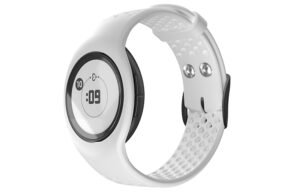Empatica Chief Medical Officer Dr. Marisa Cruz discusses advances in wearable technology and how new digital biomarkers could advance medtech.

Empatica Chief Medical Officer Dr. Marisa Cruz [Photo courtesy of Empatica]
Dr. Marisa Cruz envisions a future where unobtrusive wearable devices with advanced sensors will continuously measure and record actionable biodata without patients having to lift a finger.
Cruz is an endocrinologist and internist who serves as chief medical officer at Empatica, which develops wearable devices for monitoring patient physiology with the ultimate goal of improving clinical outcomes.
In 2011, Empatica spun out of an MIT lab focused on wearable sensors for continuous, passive patient monitoring. That technology is made possible by ever-shrinking sensors and batteries, gains in effective computing, and materials and manufacturing methods that result in comfortable and intuitive wrist-worn devices.
“Patients can wear a watch and go about their day, and data can be collected unobtrusively and seamlessly,” Cruz said in an interview with Medical Design & Outsourcing. “We really focus on that intuitive method of data collection and using that data to create digital biomarkers that ultimately, I think can improve clinical research and improve healthcare.”
Empatica’s wearable technology

Empatica’s Embrace Plus wearable has an aluminum pod, silicone band and pod casing, and e-ink display. [Image courtesy of Empatica]
In January 2018, Empatica won FDA 510(k) clearance for its Embrace seizure-tracking wristband. The devices use temperature sensors, accelerometers, electrodermal activity (EDA) sensors and machine learning software to detect and monitor seizures.
“Electrodermal activity can apply to many different types of stressors, but the ultimate physiology is in electrical conduction and sweat on the skin,” she said.
More recently, the Empatica Health Monitoring Platform and EmbracePlus device won FDA 510(k) clearance In November 2022 for the ability to continuously collect data on EDA, peripheral skin temperature, blood oxygen saturation (under no-motion conditions) and activity associated with movement during sleep. Empatica expanded on that in October 2023 with continuous data collection of pulse rate and respiratory rate.
Empatica is one of only a few werable developers that has validated EDA sensors incorporated into its devices to measure stress levels. As research yields new insights into how cognition and emotion regulate physiologic parameters, there’s increasing interest in how to combine measurements of EDA with more traditional vitals like pulse rate and respiratory rate and blood oxygen saturation to develop novel digital biomarkers.
For example, Empatica worked with Takeda to create a novel digital endpoint around sweat detection for Fabry disease patients. This ultra-rare disease can cause abnormal sweating in the form of both excessive sweating (hyperhidrosis) and inadequate sweating (hypohidrosis).
“We were trying to figure out whether there was a way to use electrodermal activity to detect between high-sweating and low-sweating groups so we would be able to measure interventions or therapeutics for Fabry disease patients and be able to understand that degree of symptomatology,” Cruz said. “… That’s just not a biomarker that is used currently as a high-sweat, low-sweat differentiation to track symptomatology of a rare disease population.”
As Empatica builds a platform that can be configured for different uses, it could move the field of digital health forward in a new way, Cruz said.

Empatica’s Embrace Plus wearable has sensors for measuring blood volume pulse, motion, electrodermal activity and skin temperature. [Image courtesy of Empatica]
“There are in the digital health market a number of point solutions — many of them add quite a bit of clinical value and have gone through a robust validation process, but are really focused on a specific scenario, a specific disease state, a specific clinical condition,” she said. “The ability to develop an infrastructure that supports configurable use states to the needs of a clinician, the needs of a patient that needs of a health care researcher is very powerful. That allows for a much more flexible and holistic approach to digital health that will be the vanguard of where this field is moving. It allows for clinicians and researchers to develop their own digital endpoints of interest for new gold standards that can be applied to clinical trials.”
These new standards could help measure subtle, physiologic phenomenons like pain or continuously monitor vitals like blood pressure rather than relying on office visits. That, in turn, could help device manufacturers with R&D, clinical trials, regulatory submissions and reimbursement bids.
“You can get a lot more nuance and depth into an understanding of how an endpoint applies to a particular disease state or a particular therapeutic intervention with the ability to take data that’s continuously gathered from wearables, and use that as a more fulsome and robust endpoint than these point in time static measurements,” Cruz said.
Advice for other device developers
Empatica’s using artificial intelligence and machine learning for biomarker development and validation, and Cruz offered some advice for device developers exploring AI and ML.
“The things that are top of mind for medical device manufacturers to consider are regulatory implications of using AI [and] data privacy security,” Cruz said. “Where are you getting the data from? How are you using it? How do you approach patient consent when data collected for one purpose might be used in a different setting? Those are very central concerns related to use of AI when you’re developing validating digital biomarkers”
Cruz also offered regulatory and compliance advice for developing software based on AI or ML.
“Understanding what the regulatory standards are for evidence generation and for algorithm validation is incredibly important up front,” she said. “Understand what your sample size is going to be, what prospective clinical data collection looks like, and what the degree of validation and sort of the acceptance criteria for performance of these algorithms needs to meet.”
Beyond software, she advised device developers to engage with patients and health care providers where they are and define user needs from a clinical standpoint very early in the process.
“You don’t want to get all the way through validating some piece of technology that [ends up] not really fit for purpose in a clinical setting or a research setting,” Cruz said. “Asking those questions up front — understanding patient preferences, how they are likely to use it, what might be pain points — very early in the process is a critical part of device development.”
She said questions about what would lead someone to stop using a device can elicit unusually insightful answers.
“There is often an early stage of adoption where people are excited about a new gadget and new technology and new ability to use data. But that can fall off over time if there’s not appropriate thought into potential barriers to continued use and what might be disincentivizing over the long term. Probing that longitudinal aspect of continued engagement with technology is useful,” Cruz said.
“I also think that a set of questions about how you might use technology to communicate with a healthcare provider is also useful,” she continued. “A download of data might be useful in a research setting, but might be less useful to a busy clinician who needs to process a visualization of the data or trend lines over time. And so what are the important things for a patient to be able to communicate easily to a healthcare provider? And how might that healthcare provider internalize and interpret that?”
What’s next for Empatica
Look for more milestones ahead from Cruz and her team as they add new biomarkers to the Empatica Health Monitoring Platform. Those new biomarkers and algorithms are undergoing regulatory review, Cruz said.
Empatica is also migrating some of its epilepsy software product to newer versions of its hardware to improve battery life and utilize new charging technology for nonstop use.
“We are also excited to expand on our epilepsy offerings and have a number of partnerships ongoing that will allow us to look at different types of seizures and even consider whether there’s applications of our technology that could be used for things like seizure forecasting,” Cruz said.